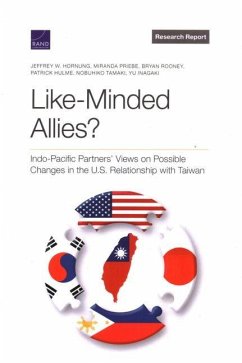
Enemies Into Allies
American Stability Operations and the Transformation of Japan, 1945-1952
Versandkostenfrei!
Versandfertig in über 4 Wochen
15,99 €
inkl. MwSt.

PAYBACK Punkte
8 °P sammeln!
The current U.S. Army operating concept prominently includes stability operations built on the core competency of wide area security. Stability operations secure national goals for military action by establishing the conditions for lasting peace after conflict or by mitigating the effects of humanitarian crisis. During the occupation of Japan following the end of World War II, American forces conducted stability operations that effectively did both. In the process, the American occupation forces transformed a defeated enemy nation into valued ally. This study identified lessons applicable to f...
The current U.S. Army operating concept prominently includes stability operations built on the core competency of wide area security. Stability operations secure national goals for military action by establishing the conditions for lasting peace after conflict or by mitigating the effects of humanitarian crisis. During the occupation of Japan following the end of World War II, American forces conducted stability operations that effectively did both. In the process, the American occupation forces transformed a defeated enemy nation into valued ally. This study identified lessons applicable to future missions from the American stability operations conducted in Japan from 1945 to 1952 by examining the strategy for the occupation, the operational plan, and the stability tasks conducted. The United States prior to 1945 adopted a strategy that defined the ends, ways, and means for occupation of Japan upon successful conclusion of combat operations in the Pacific Theater. American forces led by GEN Douglas MacArthur developed plans for occupation that translated national strategy into stability tasks to units in ways that can be examined through current doctrine's elements of operational design. The operational units of the occupation forces, like the U.S. Eighth Army, executed both initial responses and transformative actions that significantly contributed to the recovery of Japan in the post-war period. While the occupation of Japan was conducted under unique circumstances, lessons can be drawn from the American actions that set conditions for Japan's return to global prominence within the context of an alliance that has secured peace between Japan and the United States for over sixty years. This work has been selected by scholars as being culturally important, and is part of the knowledge base of civilization as we know it. This work was reproduced from the original artifact, and remains as true to the original work as possible. Therefore, you will see the original copyright references, library stamps (as most of these works have been housed in our most important libraries around the world), and other notations in the work. This work is in the public domain in the United States of America, and possibly other nations. Within the United States, you may freely copy and distribute this work, as no entity (individual or corporate) has a copyright on the body of the work. As a reproduction of a historical artifact, this work may contain missing or blurred pages, poor pictures, errant marks, etc. Scholars believe, and we concur, that this work is important enough to be preserved, reproduced, and made generally available to the public. We appreciate your support of the preservation process, and thank you for being an important part of keeping this knowledge alive and relevant.







![With the Allies [microform] Cover With the Allies [microform]](https://bilder.buecher.de/produkte/66/66196/66196536n.jpg)




